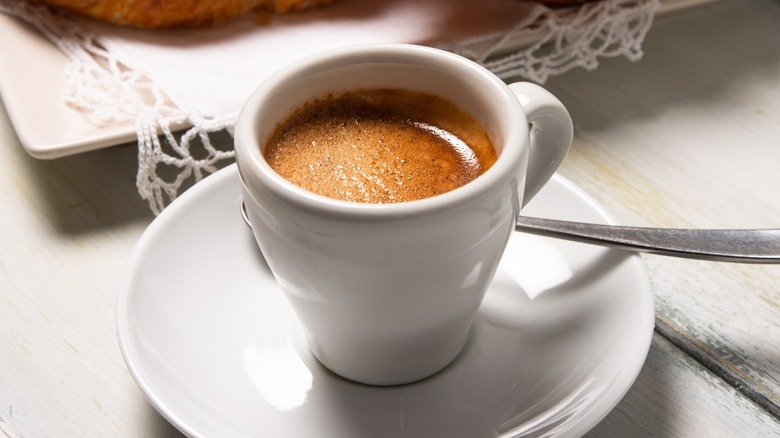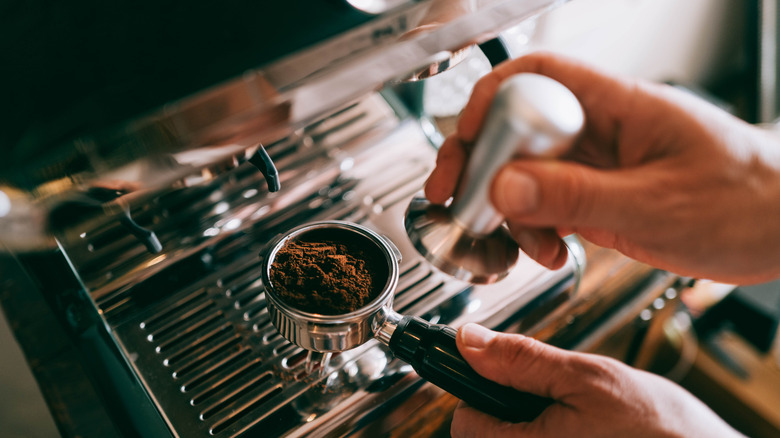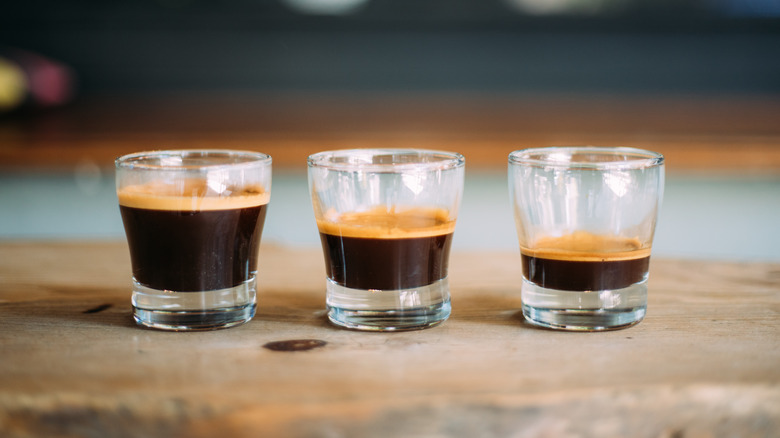The Difference Between Espresso And Ristretto Lies In How It's Brewed
The world of coffee is vast and can seem overwhelming for those unfamiliar with the various types and styles of brews. Let's start with the basics: Coffee beans get roasted at increasing temperatures for various amounts of time. When you purchase coffee, this roasting time is signified by the light, medium, or dark roast label on the bag.
Each roast provides a unique flavor profile and specific aromatic notes, and the roasting time can change the beans' caffeine content. Even though darker roasts are slightly less caffeinated than lighter ones, espresso beans, which are usually roasted for longer and at higher temperatures to enhance their flavor, contain more caffeine per ounce than a standard cup of joe. Coffee lovers drink many variations of this caffeinated beverage, from a simple drip coffee to espresso or even ristretto; what defines each of these is its brewing method.
Since each brew is different, each one results in a specific taste, mouth feel, and quantity. Drip coffee is commonly made in a pot, so even though the amount you get is customizable, the pots typically hold either six or 12 cups. With drip coffee, you can also decide how many scoops of coffee grounds to use for your preferred potency. The real difference between coffee and espresso is that the latter is brewed in a way that requires a different machine entirely.
Espresso is a type of coffee
For espresso, finely ground beans are brewed at a much higher pressure than your average cup of joe. You can either get a standard shot or a variation called ristretto. The main differences between the two are the amount of water used for brewing and how much pressure is needed.
For espresso, the ratio of water to grounds is generally quite low, giving the small amount of liquid an extremely strong coffee flavor. Regular espresso requires high brewing pressure, around 9 BARs (or units of barometric pressure) if you want an authentic end result. However, other factors like grind size and how firmly you tamped your grounds before brewing also play a role. The high pressure of the water moving through the grounds is what gives espresso its flavorful, dynamic taste, which is why packing your dry grounds exactly the right amount prior to brewing is a game of trial and error.
Since authentic espresso requires its brewing machine to provide pressure, you can't make it in a simple coffee pot — you're creating very concentrated coffee in a small amount of liquid. This is also why espresso is strong enough to be mixed with milk for lattes without losing its flavor notes. Of course, you can use a historic moka pot to make your morning espresso, but it may take some practice, especially if you're trying to pull a ristretto shot.
Low and slow is the motto for the perfect ristretto
While a regular espresso shot usually gives you 1 ounce of liquid, a ristretto shot is half that amount. In fact, it almost always comes in a double shot because of how minuscule the amount really is. Just as espresso is stronger than coffee, a ristretto shot is stronger than your average espresso shot, meaning more flavor needs to get into half the liquid.
Again, this is accomplished through a pressurized brewing process, but ristretto actually requires less pressure than regular espresso. The name means "restricted" in Italian, implying a shorter shot of espresso is pulled. At coffee shops like Starbucks, this allows for the espresso's full-bodied flavor to be captured before the second half of the shot adds any bitter or burnt notes.
If you're using your own espresso machine, like the Breville, you simply press the button to stop your shot early, around 0.5 to 0.7 fluid ounces. Traditionally, ristretto required an even finer grind than espresso, which blocked the water from flowing directly through, leading to a slower brew with a stronger flavor. Therefore, making ristretto in a moka pot will require less water and a more watchful eye since you'll have to keep it on low heat for longer. While the process might seem daunting at first, the flavor difference between espresso and ristretto is noticeable, and it's definitely worth trying for yourself.


